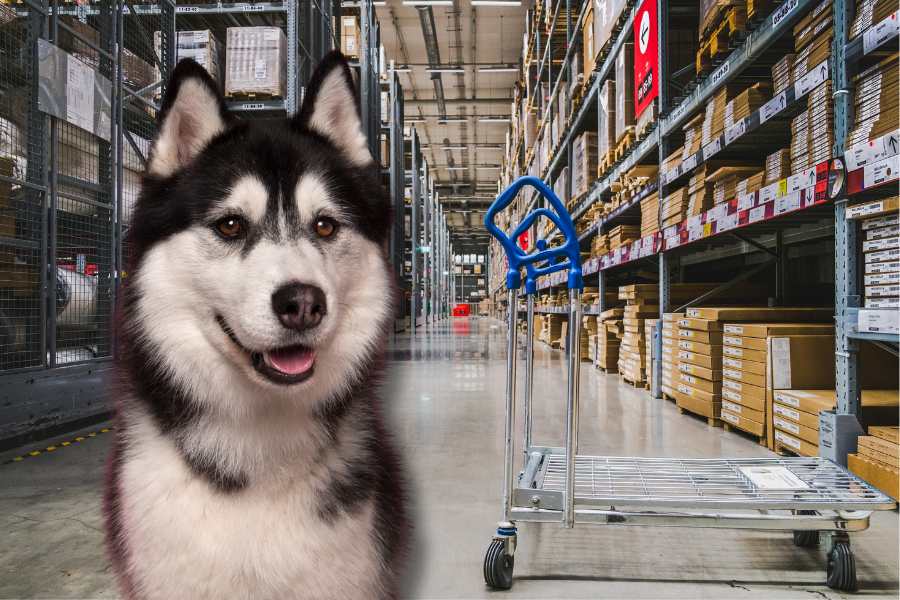
Can I Bring My Dog Into IKEA? Here’s What Their Pet Policy Says
- Published on:
- By: ASP Team
IKEA is a renowned furniture retailer offering a wide range of affordable and stylish home furnishing products. Many customers spend hours exploring the showrooms, testing out furniture, and even enjoying a meal at the IKEA restaurant. However, when it comes to pets, there are clear guidelines shoppers need to follow.
In the U.S., dogs are not allowed inside IKEA stores unless they are trained service animals. While some international IKEA locations may be pet-friendly, all U.S. stores adhere to a strict no-pet policy. This policy ensures compliance with public health regulations and maintains a safe, clean, and welcoming environment for all customers.
In this article, we’ll review IKEA’s official pet policy, clarify what qualifies as a service animal under U.S. law, and provide guidance on training your dog to meet public access standards through American Service Pets’ iTrain Academy and PSA letter services.
What Is IKEA’s Official Pet Policy in the U.S.?
IKEA’s U.S. customer service confirms:
Only service animals trained to assist individuals with disabilities are allowed inside IKEA stores.
That means:
- Pets are not allowed—regardless of size, breed, or temperament
- Emotional Support Animals (ESAs) are also not permitted
- Only ADA-recognized service dogs are accepted in-store
This policy applies consistently across all IKEA locations in the United States and is enforced at the entrance.
What Is IKEA’s Official Pet Policy in the U.S.?
IKEA enforces a no-pet policy for several important reasons. Foremost, the presence of animals conflicts with U.S. food safety regulations, as IKEA locations include food courts, cafes, and restaurants where only ADA-designated service animals are permitted. This policy ensures compliance with health codes and safeguards the integrity of food preparation areas.
Additionally, permitting untrained animals in a busy retail environment introduces potential risks, such as accidents, product damage, or disruptive behavior like barking, which could detract from the shopping experience.
Another significant factor is customer comfort. Many shoppers may have allergies or fears related to animals, and restricting pets helps foster a welcoming and inclusive environment for all visitors. By maintaining a no-pet policy, IKEA prioritizes safety, hygiene, and customer satisfaction, ensuring a high standard of cleanliness and order across its stores.
Get Your ESA Today
What Counts as a Service Animal?
The Americans with Disabilities Act (ADA) defines a service animal as a dog (or, in some cases, a miniature horse) that is individually trained to perform specific tasks related to a disability. These tasks must directly assist the person with their disability to qualify under the ADA.
Examples of such tasks include guiding individuals with visual impairments, detecting seizures or low blood sugar, interrupting self-harming behaviors, or providing deep pressure therapy during panic attacks.
It’s important to note that simply offering comfort or companionship, while valuable, does not meet the ADA’s criteria for service animal protection. The distinction lies in the animal being trained to take specific actions that mitigate a disability. This ensures that service animals provide vital, task-oriented support for those who rely on them in their daily lives.
Does the Breed of a Service Animal Matter?
The breed of a service animal is not inherently significant as long as the animal can effectively perform the tasks it has been trained to accomplish.
While breeds such as Labrador Retrievers and German Shepherds are commonly chosen due to their intelligence, temperament, and trainability, any breed can qualify as a service animal if it meets the necessary requirements.
The primary considerations are the animal’s ability to perform its designated duties, its behavior in public settings, and its capacity to remain focused and calm in various environments.
That said, the physical characteristics of certain breeds may impact their suitability for specific tasks. For instance, smaller breeds may not be ideal for mobility assistance. Ultimately, the appropriateness of a breed is determined by the specific needs of the individual and the training and capabilities of the animal.
How to Qualify for a Psychiatric Service Animal (PSA)
If your Emotional Support Animal (ESA) helps you manage mental health conditions like PTSD, anxiety, or panic attacks, it may qualify as a Psychiatric Service Animal (PSA).
To meet legal requirements, your dog must be trained to perform at least one specific task that supports your mental health, such as providing tactile stimulation during distress or alerting you to an impending panic attack. Additionally, your dog must remain calm and well-behaved in public settings to meet the necessary standards.
Once these criteria are met and your dog supports a documented mental health disability, it officially becomes a Psychiatric Service Animal. This designation grants you full ADA access rights, allowing your PSA to accompany you in public spaces, including stores like IKEA. A PSA can provide invaluable assistance while offering greater freedom and accessibility to those who need it.
Train Your Dog with iTrain Academy
iTrain Academy, developed by American Service Pets, is a powerful online training platform that:
- Helps dog owners teach basic and advanced obedience
- Prepares dogs for real-world distractions
- Covers task-based training for psychiatric service work
Key Benefits:
- 100% online video lessons
- Just 15 minutes per day
- Designed by professional service dog trainers
- Works for dogs of all breeds and ages
Whether you’re preparing your dog for public access or building advanced task performance, iTrain Academy can help you get there—without expensive in-person classes.
How to Get a PSA Letter from a Licensed Professional
Need a service animal? American Service Pets makes it easy to get a Psychiatric Service Animal (PSA) letter.
This letter, written by a licensed mental health professional, confirms that you have a qualifying condition, your service animal helps you in daily life, and you qualify for ADA accommodations. With this letter and proper training, your service animal can join you in public places, even spots like IKEA!
The process is quick and stress-free. Just start by filling out a simple questionnaire about your needs. From there, you’ll be connected with a licensed provider in your state for a virtual evaluation. If approved, your PSA letter will arrive in your inbox.
At American Service Pets, we’re here to make the process smooth and legit, so you can get the support you need without any hassle!
Mistakes To Avoid When Visiting IKEA With a Service Dog
There are a few things to keep in mind when visiting IKEA with your service dog. Making these mistakes can lead to discomfort or even being asked to leave the store.
Not Bringing Proper Documentation
It’s important to always have your PSD (Psychiatric Service Dog) letter or any other documentation that proves the legitimacy of your service dog. This helps avoid any misunderstandings or conflicts with store employees. Make sure the documentation is up to date and clearly states the tasks your service dog is trained to perform for you.
Not Having Your Dog on a Leash
Even though your service dog is trained to stay by your side, it’s still important to have them on a leash at all times when in public places like IKEA. This not only ensures their safety but also prevents them from wandering off and potentially causing any disruptions within the store.
Allowing Unnecessary Interactions
Many people are naturally drawn to dogs and may want to pet or play with your service dog while you’re shopping. It’s important to politely inform them that your dog is working and should not be distracted. This also helps reinforce the boundaries for your service dog and prevents them from getting overly excited or distracted.
Proper Etiquette in Public Places
While your service dog may be trained to handle various situations, it’s always important to be mindful of proper etiquette when bringing them into public places like IKEA. This includes keeping them on a leash, cleaning up after them if they have an accident, and not allowing them on furniture or in shopping carts.
International IKEA Stores May Differ
IKEA store rules for pets can vary depending on the country, so it’s always best to check before bringing your furry friend along.
For example, in Catania, Italy, IKEA gained attention for allowing stray dogs to take shelter inside during the winter. In Germany, some stores provide “dog parking” areas outside their entrances for pet owners. Meanwhile, in Taiwan, dogs are welcome inside as long as they are carried in a bag or trolley.
These examples highlight how different locations adapt their policies to suit local needs and norms. Whether you’re traveling or relocating with a pet, it’s essential to confirm the rules for the specific IKEA store you plan to visit. Understanding these guidelines ensures a smooth experience for you, your pet, and other customers while respecting the store’s policies.
Summary: Can I Bring My Dog Into IKEA?
In the United States, IKEA enforces a strict no-pet policy in its stores, permitting only trained service animals as defined by the ADA. This policy prioritizes public safety, food safety compliance, and customer comfort. It is important to note that emotional support or psychological support dogs do not meet the ADA criteria for service animals and are therefore not allowed in IKEA stores.
For individuals who rely on their dog for emotional support, there are steps you can take to expand your dog’s access rights. Training through programs like iTrain Academy can help prepare your dog for specific service tasks.
Additionally, obtaining a Psychiatric Service Animal (PSA) letter and pursuing full ADA compliance can qualify your dog as a service animal. With the appropriate training and certification, your dog may gain service animal status and accompany you in more public spaces.
Final Thoughts: Turn Restriction Into Empowerment
Getting denied access with your emotional support animal can be super frustrating, but don’t worry—it doesn’t have to stop there!
With the right training and guidance, you can turn your dog into a fully recognized Psychiatric Service Animal. This upgrade opens doors (literally!) to places like IKEA, airlines, and other service animal-friendly spots. It’s a big step toward making sure you get the support you need in everyday life.
At American Service Pets, we’re here to make the process simple and stress-free. From easy-to-follow training to seamless certification, we’ve got your back. Our mission is to help you and your service animal feel confident navigating public spaces, so you can enjoy the freedom and support to live your best life. Let’s make it happen together!

The benefits of an Emotional Support Animal certification and a Psychiatric Service Dog certification are drastically different. Fortunately for you, American Service Pets’ network of active board certified doctor or other licensed mental health providers can help you find the right path to certification. To find out whether you need an ESA or PSD letter, take our easy, three-step Pet Owner Survey!
More Great Resources





